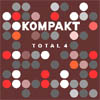 Both experimental electronic producers and tech-house DJs alike show a reverence for the highly-imitated Cologne sound. The same respect applies to the city's own Kompakt label, which continues to put out slabs and discs of dubby analogue deepness. For the fourth installment of the Total series, some of the previously-released tracks from the past year are compiled alongside cuts from upcoming singles. Though I enjoy the tech-house sound quite a bit, most of the material on here is forgettable, not to say that those songs are necessarily bad. From a DJ's perspective, there are too many "transition" tracks that can help keep a set moving along, but really fail to give it any luster or polish. The exceptions, however, are the type of tracks that make labels famous. Jürgen Paape offers "Mit Dir," an unusually Germanic-flavored slice of neo-disco that left me equally puzzled and entertained. Similar to Vladislav Delay's work under the Luomo moniker, M. Mayer's "Falling Hands" features near-whispered vocals ("I'm falling in love") over a deep bassline, delay-treated kicks, and airy strings. Autobianchi's "All Around (Everybody's Kissing)" is driving vocal house worthy of play alongside recent stormers like "Nightclubbing At Home" from MRI. The sex appeal that emanates from this song recalls ecstasy-fueled orgiastic foreplay in a club or at a rave, the kind that only ever happens in late-night movies and the fantasies of confirmed perverts like myself. Though there are some genuine disasters here (namely the dismal electroclash craze cash-in cover song from Superpitcher), 'Total 4' holds its own as a decent, though often boring, collection of one region's current contributions to the ever-growing international tech-house scene. These pretzels are making me thirsty.
Both experimental electronic producers and tech-house DJs alike show a reverence for the highly-imitated Cologne sound. The same respect applies to the city's own Kompakt label, which continues to put out slabs and discs of dubby analogue deepness. For the fourth installment of the Total series, some of the previously-released tracks from the past year are compiled alongside cuts from upcoming singles. Though I enjoy the tech-house sound quite a bit, most of the material on here is forgettable, not to say that those songs are necessarily bad. From a DJ's perspective, there are too many "transition" tracks that can help keep a set moving along, but really fail to give it any luster or polish. The exceptions, however, are the type of tracks that make labels famous. Jürgen Paape offers "Mit Dir," an unusually Germanic-flavored slice of neo-disco that left me equally puzzled and entertained. Similar to Vladislav Delay's work under the Luomo moniker, M. Mayer's "Falling Hands" features near-whispered vocals ("I'm falling in love") over a deep bassline, delay-treated kicks, and airy strings. Autobianchi's "All Around (Everybody's Kissing)" is driving vocal house worthy of play alongside recent stormers like "Nightclubbing At Home" from MRI. The sex appeal that emanates from this song recalls ecstasy-fueled orgiastic foreplay in a club or at a rave, the kind that only ever happens in late-night movies and the fantasies of confirmed perverts like myself. Though there are some genuine disasters here (namely the dismal electroclash craze cash-in cover song from Superpitcher), 'Total 4' holds its own as a decent, though often boring, collection of one region's current contributions to the ever-growing international tech-house scene. These pretzels are making me thirsty.
samples:
- Jurgen Paape - Mit Dir
- M. Mayer - Falling Hands
- Autobianchi - All Around


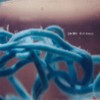 With his well-received debut album "Approximate Love Boat", Danny Zelonky emerged as Low Res with experimental electronic music in a style all his own. Low Res takes samples of a broad range of instruments and creates engrossing yet completely disparate music with them. It's clear that Zelonky, like a recent wave of electronic artists, believes that the best music is created through this approach, not through cheaply synthesized recreations that never sound genuine. But it's the way he accomplishes this goal on his second LP "Blue Ramen" that is truly ingenious. Even with real instruments at his disposal - including real drums and percussion - nearly every beat and sound is programmed on these songs. The instruments were not recorded the way they are played and then assembled in a collage with beats. Every note is placed there in a systematic piece-by-piece approach. So what escapes from the speakers sounds at once improvised and freeform, like a group of musicians playing together, when in fact every part of it is structured meticulously by Low Res to help end the "cheap karaoke" sound of synths and samplers. The results are interesting, but a bit of a grab-bag. Different rhythms and tastes abound - from the Latin-tinged album opener 'Shaftasia' to the almost jazz shuffle of 'Inverse Shift' - which gives the release a schizophrenic feel. Low Res just seems to create whatever music he wants, with no regard for a common theme or style. "Ramen" also features the debut of a rather strange electronic wind instrument, one Zelonky calls the "ersax", and abundant strains of Low Res' favorite instrument: the organ. It makes your toe tap in areas, makes your hips shake in others, and makes your brain hurt in still others, but never all at once. The songs are a rather disjointed listen, which is unfortunate considering the skill and creativity involved. It's rumored that Low Res intends to assemble a live band to tour behind "Blue Ramen", and that would be a treat. For the record, though, it would work so much better with a common theme or genre to give it backbone. Still a fine effort from a talented musician.
With his well-received debut album "Approximate Love Boat", Danny Zelonky emerged as Low Res with experimental electronic music in a style all his own. Low Res takes samples of a broad range of instruments and creates engrossing yet completely disparate music with them. It's clear that Zelonky, like a recent wave of electronic artists, believes that the best music is created through this approach, not through cheaply synthesized recreations that never sound genuine. But it's the way he accomplishes this goal on his second LP "Blue Ramen" that is truly ingenious. Even with real instruments at his disposal - including real drums and percussion - nearly every beat and sound is programmed on these songs. The instruments were not recorded the way they are played and then assembled in a collage with beats. Every note is placed there in a systematic piece-by-piece approach. So what escapes from the speakers sounds at once improvised and freeform, like a group of musicians playing together, when in fact every part of it is structured meticulously by Low Res to help end the "cheap karaoke" sound of synths and samplers. The results are interesting, but a bit of a grab-bag. Different rhythms and tastes abound - from the Latin-tinged album opener 'Shaftasia' to the almost jazz shuffle of 'Inverse Shift' - which gives the release a schizophrenic feel. Low Res just seems to create whatever music he wants, with no regard for a common theme or style. "Ramen" also features the debut of a rather strange electronic wind instrument, one Zelonky calls the "ersax", and abundant strains of Low Res' favorite instrument: the organ. It makes your toe tap in areas, makes your hips shake in others, and makes your brain hurt in still others, but never all at once. The songs are a rather disjointed listen, which is unfortunate considering the skill and creativity involved. It's rumored that Low Res intends to assemble a live band to tour behind "Blue Ramen", and that would be a treat. For the record, though, it would work so much better with a common theme or genre to give it backbone. Still a fine effort from a talented musician. The first release in the new Raster-Post series from Raster Noton, this CD is unsurprisingly eye-catching, at least in its limited-to-1000-pieces form. (It comes in a matte-black card case held closed with a black elastic cord, a distinctive red dot, and subtle black and stark white type.) On the one hand, it is a truly beautiful recording, both musically and, importantly for this sort of abstract, minimal electronica, in its production, which is occasionally stunning. On the other hand, it's a perfect example of genre music, with virtually nothing original about it. Instead, it imitates the classics of post-Oval glitch music to the most slavish extent: there are what could only generously be called "echoes" of Oval, Microstoria, Fennesz, Vladislav Delay, and Pole, to name the most obvious. More often than not the originals seem to have been sampled.
The first release in the new Raster-Post series from Raster Noton, this CD is unsurprisingly eye-catching, at least in its limited-to-1000-pieces form. (It comes in a matte-black card case held closed with a black elastic cord, a distinctive red dot, and subtle black and stark white type.) On the one hand, it is a truly beautiful recording, both musically and, importantly for this sort of abstract, minimal electronica, in its production, which is occasionally stunning. On the other hand, it's a perfect example of genre music, with virtually nothing original about it. Instead, it imitates the classics of post-Oval glitch music to the most slavish extent: there are what could only generously be called "echoes" of Oval, Microstoria, Fennesz, Vladislav Delay, and Pole, to name the most obvious. More often than not the originals seem to have been sampled. With the recent rise in popularity of such abrasive artists as Venetian Snares and Somatic Responses, now seems like a perfect time to revive the scene formerly known as digital hardcore/breakcore. Ambush has always been a major player here, dropping releases of "hazardous sounds" from kingpins like Panacea and DJ Scud for some time. Fans of the aforementioned acts will surely enjoy the grim vibe of Noize Creator. This twenty-eight minute EP contains seven rather indistinguishable tracks of beats, noise, and dark ambient atmospheres. The significant downside to this CD is how sonically similar it all sounds. Noize Creator uses the same formulaic elements throughout, but randomizes them in such a way that they're supposed to be separate tracks. However, I've been listening to this on-and-off for weeks, and if you quizzed me on which song was which, I certainly couldn't tell you. That being said, the material itself is fierce, fast, and furious. Heavy industrial sounds merge with mangled drum loops (often with unclear, changing time signatures) on DJ-unfriendly tracks like "Hate Cops" and "Per Thousand." The beats hit with brute force and achieve maximum results though a sound system that can handle the bass. There are two remixes on here which both keep with the album's distorted sense of flow. "NBK (South London mix)" combines Rotterdam gabber with neck-snapping breakbeats and abrupt chord changes. "Hate Cops (remix)" charges ahead with the intensity of the original, but with an even greater sense of chaos. All in all, 'Deferred Media' is strictly for the noiseheads, and definitely not for the uninitiated.
With the recent rise in popularity of such abrasive artists as Venetian Snares and Somatic Responses, now seems like a perfect time to revive the scene formerly known as digital hardcore/breakcore. Ambush has always been a major player here, dropping releases of "hazardous sounds" from kingpins like Panacea and DJ Scud for some time. Fans of the aforementioned acts will surely enjoy the grim vibe of Noize Creator. This twenty-eight minute EP contains seven rather indistinguishable tracks of beats, noise, and dark ambient atmospheres. The significant downside to this CD is how sonically similar it all sounds. Noize Creator uses the same formulaic elements throughout, but randomizes them in such a way that they're supposed to be separate tracks. However, I've been listening to this on-and-off for weeks, and if you quizzed me on which song was which, I certainly couldn't tell you. That being said, the material itself is fierce, fast, and furious. Heavy industrial sounds merge with mangled drum loops (often with unclear, changing time signatures) on DJ-unfriendly tracks like "Hate Cops" and "Per Thousand." The beats hit with brute force and achieve maximum results though a sound system that can handle the bass. There are two remixes on here which both keep with the album's distorted sense of flow. "NBK (South London mix)" combines Rotterdam gabber with neck-snapping breakbeats and abrupt chord changes. "Hate Cops (remix)" charges ahead with the intensity of the original, but with an even greater sense of chaos. All in all, 'Deferred Media' is strictly for the noiseheads, and definitely not for the uninitiated.  The debut solo album by Aidan Moffat, one half of Glaswegian duo Arab Strap, was born out of insomnia. Unable to tolerate most "chill-out" music, Moffat assembled pieces from sounds he found to be conducive to sleep. The result is a record luxurious in sound, yet straightforward in construction. 'Hypnogogia' is surprisingly diverse for an album intended to induce sleep. Both "Angels on Your Body" and "Shatterproof" are sultry mixes of sensuously melancholy strings and slow, bassy beats. Meanwhile, "Nurse Flamingo", with its bizarre, charming silliness, sounds as if it would be right at home in a Terry Gilliam film. The pieces run the gamut from exotic, tribal vocals to opera samples over echoey piano notes. Moffat meticulously compiled the track order so that each side of the vinyl version of the album allowed the listener to relax gradually and then drift off to sleep at the end. "The Heart of All That Is" and "Bedwomb", tracks five and ten on the CD (the last tracks on either side of the vinyl version) have the ability to leave the listener in an oneiric suspension between wakefulness and unconsciousness. The man behind Lucky Pierre has surely succeeded in his mission, as I sit here listening to the album come to a close, with my eyelids fluttering, feeling the magnetic lure of my down comforter.
The debut solo album by Aidan Moffat, one half of Glaswegian duo Arab Strap, was born out of insomnia. Unable to tolerate most "chill-out" music, Moffat assembled pieces from sounds he found to be conducive to sleep. The result is a record luxurious in sound, yet straightforward in construction. 'Hypnogogia' is surprisingly diverse for an album intended to induce sleep. Both "Angels on Your Body" and "Shatterproof" are sultry mixes of sensuously melancholy strings and slow, bassy beats. Meanwhile, "Nurse Flamingo", with its bizarre, charming silliness, sounds as if it would be right at home in a Terry Gilliam film. The pieces run the gamut from exotic, tribal vocals to opera samples over echoey piano notes. Moffat meticulously compiled the track order so that each side of the vinyl version of the album allowed the listener to relax gradually and then drift off to sleep at the end. "The Heart of All That Is" and "Bedwomb", tracks five and ten on the CD (the last tracks on either side of the vinyl version) have the ability to leave the listener in an oneiric suspension between wakefulness and unconsciousness. The man behind Lucky Pierre has surely succeeded in his mission, as I sit here listening to the album come to a close, with my eyelids fluttering, feeling the magnetic lure of my down comforter.  Some bands like a little variety on their releases. They don't mind if one song on the album sounds like a different band than the one before or after it. They don't even mind if every song sounds like a different band. Other bands use different albums or EPs to try out different concepts. In the case of Arco Flute Foundation, the members started another band entirely to put out this music. Arco Flute Foundation is the same principals who are in Meisha, but recording as such because the music is that much removed from their former selves. Meisha are languid, slight, and melodic with a subdued energy, recording instrumentals that are lush and captivating. Arco Flute Foundation, on the other hand, is more interested in loud, boisterous, loose instrumental rock. 'Everything After' is their third release on Cenotaph, and it is their most adventurous yet. More electronics, more Slint-like guitar antics, more distortion, and more ambient noise appear on these songs than have in the past. These passages are still unfocused and raw, however, with the band members seemingly exploring the space around them with these compositions. There are two tracks under the four-minute mark that seem to be the more structured songs (more accessible?), but beyond that the Foundation just let it bleed, adding and subtracting elements as the song progresses, trying to find their happy hunting ground. Honestly, it has some very interesting elements, but the two shorter songs are the best tracks solely because of their structure. The album's closer, "Seymour Uncle Billy," approaches what seems like the true sound of the band, a balance between the structure and improvisation, between the noise and the music. Now that they seem to have all of the instruments and sounds they want to explore, that should be the next area to perfect. Which means the next Arco Flute Foundation release could be a fine one, indeed.
Some bands like a little variety on their releases. They don't mind if one song on the album sounds like a different band than the one before or after it. They don't even mind if every song sounds like a different band. Other bands use different albums or EPs to try out different concepts. In the case of Arco Flute Foundation, the members started another band entirely to put out this music. Arco Flute Foundation is the same principals who are in Meisha, but recording as such because the music is that much removed from their former selves. Meisha are languid, slight, and melodic with a subdued energy, recording instrumentals that are lush and captivating. Arco Flute Foundation, on the other hand, is more interested in loud, boisterous, loose instrumental rock. 'Everything After' is their third release on Cenotaph, and it is their most adventurous yet. More electronics, more Slint-like guitar antics, more distortion, and more ambient noise appear on these songs than have in the past. These passages are still unfocused and raw, however, with the band members seemingly exploring the space around them with these compositions. There are two tracks under the four-minute mark that seem to be the more structured songs (more accessible?), but beyond that the Foundation just let it bleed, adding and subtracting elements as the song progresses, trying to find their happy hunting ground. Honestly, it has some very interesting elements, but the two shorter songs are the best tracks solely because of their structure. The album's closer, "Seymour Uncle Billy," approaches what seems like the true sound of the band, a balance between the structure and improvisation, between the noise and the music. Now that they seem to have all of the instruments and sounds they want to explore, that should be the next area to perfect. Which means the next Arco Flute Foundation release could be a fine one, indeed.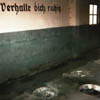 A perfect assemblage of absurd clichés has been collected here by Organum's David Jackman. The cover and title both suggest something of both the dark and sinister mindsets: 'Verhalte Dich Ruhig' translates to English literally as 'Keep yourself calm,' but more aggressively could be referred to as 'Duck and cover'. The picture, on the other hand, may have been taken in an abandoned concentration camp or some completely harmless old house in Germany, but you'll never know for sure.
A perfect assemblage of absurd clich√©s has been collected here by Organum's David Jackman. The cover and title both suggest something of both the dark and sinister mindsets: 'Verhalte Dich Ruhig' translates to English literally as 'Keep yourself calm,' but more aggressively could be referred to as 'Duck and cover'. The picture, on the other hand, may have been taken in an abandoned concentration camp or some completely harmless old house in Germany, but you'll never know for sure.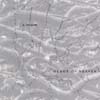 Using vinyl as an anachronistic commentary on technology and culture is all too common these days, but on this release, Loren Chasse takes a far more low-level view of the medium. He explores the detail inherent in the surface noise of records—kind of an analog representation of the digital "glitch"—and also juxtaposes it with similar sounds found in nature, such as wind, leaves, fire, and surf. The first of four untitled tracks combines layers of quiet cracking and popping with some distant-sounding music that's probably also coming from the record. The vinyl noises, spread throughout the stereo field, are continuously changing, and though they're simple and commonplace sounds, their combination with the soothingly indistinct music is warm and hypnotizing. The second track is significantly more aggressive, with louder, more distorted surface noises mixed with the sounds of wind and the ocean. There's considerable detail throughout the piece, but at times it's covered by such a thick wall of noise that close attention becomes necessary. What's fascinating is that this storm of sound, that at first seemed to overwhelm and mask the piece, holds in itself a deep level of richness and complexity. The third track is more dynamic, starting with some electronic hissing and buzzing and a little bit of crackle fading in and out, along with more barely perceptible music. It ebbs and flows while building up, like the tide that it samples, until it finally grows into a tumultuous roar. The final track is my favorite, as it features the best arrangement of the quietly melodic music submerged under what sounds like sand falling and the buzzing of a few really scratched up records. In all, 'Hedge of Nerves' is an interesting album with some moments of great subtle beauty. Though it may not be the best record for casual listening, it isn't too "conceptual" to be entertaining. According to Anomalous, it was designed in part to be used to make "virtual scratchy records" by mixing it with other sources, and it definitely succeeds in that and more.
Using vinyl as an anachronistic commentary on technology and culture is all too common these days, but on this release, Loren Chasse takes a far more low-level view of the medium. He explores the detail inherent in the surface noise of records—kind of an analog representation of the digital "glitch"—and also juxtaposes it with similar sounds found in nature, such as wind, leaves, fire, and surf. The first of four untitled tracks combines layers of quiet cracking and popping with some distant-sounding music that's probably also coming from the record. The vinyl noises, spread throughout the stereo field, are continuously changing, and though they're simple and commonplace sounds, their combination with the soothingly indistinct music is warm and hypnotizing. The second track is significantly more aggressive, with louder, more distorted surface noises mixed with the sounds of wind and the ocean. There's considerable detail throughout the piece, but at times it's covered by such a thick wall of noise that close attention becomes necessary. What's fascinating is that this storm of sound, that at first seemed to overwhelm and mask the piece, holds in itself a deep level of richness and complexity. The third track is more dynamic, starting with some electronic hissing and buzzing and a little bit of crackle fading in and out, along with more barely perceptible music. It ebbs and flows while building up, like the tide that it samples, until it finally grows into a tumultuous roar. The final track is my favorite, as it features the best arrangement of the quietly melodic music submerged under what sounds like sand falling and the buzzing of a few really scratched up records. In all, 'Hedge of Nerves' is an interesting album with some moments of great subtle beauty. Though it may not be the best record for casual listening, it isn't too "conceptual" to be entertaining. According to Anomalous, it was designed in part to be used to make "virtual scratchy records" by mixing it with other sources, and it definitely succeeds in that and more. As a listener, one of the more celebrated things about some prolific independent artists gaining more deserved recognition would be the availability of previous material that may have originally been issued in limited quantities, or else did not have as wide a distribution as present. Formerly released as a three-track twelve inch EP limited to 1,000 copies, the Scott Herren project of Delarosa + Asora's 'Crush the Sight-Seers' has recently materialized on CD through Chicago's Hefty Records, home to Herren's Savath + Savalas. In keeping with the added value of some reissues, a bonus track has been included. The recurring distorted keyboard chatters and metallic percussion sample of the opening track "OSSABAW" blends into a sub-bass progression and laid-back, half-time groove with the odd break to mark off sections of the tune. The two-and-a-half minute "OSS.BW" is a multi-layered piece of eerie drones, synth squelches and chimes that could be the equivalent of sound painting through channel surfing at a mixing console. "Airbrush (clogged)" builds from distorted vocal snippets and reverbed static to a cordial bass line and mid-tempo electro-percussion groove with a gradually building back beat. Eventually it all falls away leaving the distant sounds of distorted keyboards and squelchy tape shuttling. "Vs. Boah" skitters from static pops, sound layers and vocal samples to a dark sounding danceable groove which builds in intensity after each lengthy break. A shift in the key signature makes from a great release from all the tension the track builds. Dropping out just shy of the five minute mark for two-and-a-half minutes of silence, the music returns with an echo to the drones and hisses of "OSS.BW" to close off. While this disc may be an acquired taste as it's not as groove-oriented or melodically friendly as other Scott Herren projects, I'd have to say that it still makes for a great listen for just those reasons too. As mentioned in the liner notes, another good thing about CD reissues of unmarked RPM vinyl is hearing the tunes at the speed they were intended to be played at without any doubt.
As a listener, one of the more celebrated things about some prolific independent artists gaining more deserved recognition would be the availability of previous material that may have originally been issued in limited quantities, or else did not have as wide a distribution as present. Formerly released as a three-track twelve inch EP limited to 1,000 copies, the Scott Herren project of Delarosa + Asora's 'Crush the Sight-Seers' has recently materialized on CD through Chicago's Hefty Records, home to Herren's Savath + Savalas. In keeping with the added value of some reissues, a bonus track has been included. The recurring distorted keyboard chatters and metallic percussion sample of the opening track "OSSABAW" blends into a sub-bass progression and laid-back, half-time groove with the odd break to mark off sections of the tune. The two-and-a-half minute "OSS.BW" is a multi-layered piece of eerie drones, synth squelches and chimes that could be the equivalent of sound painting through channel surfing at a mixing console. "Airbrush (clogged)" builds from distorted vocal snippets and reverbed static to a cordial bass line and mid-tempo electro-percussion groove with a gradually building back beat. Eventually it all falls away leaving the distant sounds of distorted keyboards and squelchy tape shuttling. "Vs. Boah" skitters from static pops, sound layers and vocal samples to a dark sounding danceable groove which builds in intensity after each lengthy break. A shift in the key signature makes from a great release from all the tension the track builds. Dropping out just shy of the five minute mark for two-and-a-half minutes of silence, the music returns with an echo to the drones and hisses of "OSS.BW" to close off. While this disc may be an acquired taste as it's not as groove-oriented or melodically friendly as other Scott Herren projects, I'd have to say that it still makes for a great listen for just those reasons too. As mentioned in the liner notes, another good thing about CD reissues of unmarked RPM vinyl is hearing the tunes at the speed they were intended to be played at without any doubt.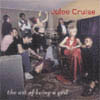 The story goes like this: David Lynch wanted to use This Mortal Coil's haunting version of Tim Buckley's "Song to a Siren" for a pivotal scene in his classic film "Blue Velvet." Something about Elizabeth Frasier's ethereal, wavering voice and the echoing acoustic guitar was perfect for a particular scene in the film. For the rights to use the song, 4AD wanted a figure that was half the budget of the film he was making. Deeply disappointed that he could not afford the song, he asked the film's composer, Angelo Badalamenti, to write and produce a track that had a similar "feel". Badalamenti found a singer with the voice of an angel, Julee Cruise, an unknown who had been working off-off-Broadway, and with lyrics penned by Lynch, they composed the song "Mysteries of Love".
The story goes like this: David Lynch wanted to use This Mortal Coil's haunting version of Tim Buckley's "Song to a Siren" for a pivotal scene in his classic film "Blue Velvet." Something about Elizabeth Frasier's ethereal, wavering voice and the echoing acoustic guitar was perfect for a particular scene in the film. For the rights to use the song, 4AD wanted a figure that was half the budget of the film he was making. Deeply disappointed that he could not afford the song, he asked the film's composer, Angelo Badalamenti, to write and produce a track that had a similar "feel". Badalamenti found a singer with the voice of an angel, Julee Cruise, an unknown who had been working off-off-Broadway, and with lyrics penned by Lynch, they composed the song "Mysteries of Love". I love the way CDs are programmable. For instance, I can take a disc like this one, with a strong opening, "Clear a Space for the King," which conjurs up space aliens grooving on a flashy dancefloor and listen along with the calm and pretty "Sprinkling Time," completely avoiding songs like "Transylvanian Spy" with its irritating, tinny two-bar melodies and "Lonely Stars" with its obnoxious fake piano riff that makes me want to throw things across the room. Reading the song titles, the record label's web site, and the distributor's release notes, each account for this album almost completely contradicts the others: ranging from a fascination with science fiction to the imitation of stomach and digestive sounds to references of musique concrête. While most of the music here is decent, I can't justify it receiving as much over-evaluation. Clearly, the one-man person behind Wang Inc., Italian Bartolomeo Sailer, is a talented individual, with a meticulous amount of attention paid to every instrument sound in each of the fifteen tracks. Rarely are sounds recycled from track to track. Comical punchiness on tracks like "Sonic Killer" would appease many Sonig fans while "Forgotten Kurdish Workers" can easily appeal to any lover of the spaceship hum from a black and white film. A little more patience with the melodies and a lot more discretion when deciding what to omit might be nicer, however.
I love the way CDs are programmable. For instance, I can take a disc like this one, with a strong opening, "Clear a Space for the King," which conjurs up space aliens grooving on a flashy dancefloor and listen along with the calm and pretty "Sprinkling Time," completely avoiding songs like "Transylvanian Spy" with its irritating, tinny two-bar melodies and "Lonely Stars" with its obnoxious fake piano riff that makes me want to throw things across the room. Reading the song titles, the record label's web site, and the distributor's release notes, each account for this album almost completely contradicts the others: ranging from a fascination with science fiction to the imitation of stomach and digestive sounds to references of musique concrête. While most of the music here is decent, I can't justify it receiving as much over-evaluation. Clearly, the one-man person behind Wang Inc., Italian Bartolomeo Sailer, is a talented individual, with a meticulous amount of attention paid to every instrument sound in each of the fifteen tracks. Rarely are sounds recycled from track to track. Comical punchiness on tracks like "Sonic Killer" would appease many Sonig fans while "Forgotten Kurdish Workers" can easily appeal to any lover of the spaceship hum from a black and white film. A little more patience with the melodies and a lot more discretion when deciding what to omit might be nicer, however.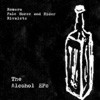 The concept is interesting for a compilation to say the least: three bands recording songs that are influenced by or created under the influence of alcohol. It could be an absolute disaster, but here it works quite nicely. Then again, the artists featured here are no slouches (even though they may be out of their element a bit).
The concept is interesting for a compilation to say the least: three bands recording songs that are influenced by or created under the influence of alcohol. It could be an absolute disaster, but here it works quite nicely. Then again, the artists featured here are no slouches (even though they may be out of their element a bit). Forgive my cliché use of a metaphor, but I somehow feel that when I listen to this disc, I'm looking at a fairly decorative car that simply doesn't go anywhere. Spaceheads have been churning out this same formula for years: a dubby pretense, a small amount of recycled and reused, two-bar repetitive sequences, some live drum playing and trumpet with loads of delay effects. The formula's getting old. While their music is undoubtedly pleasant enough for an escalator ride, and the band has earned a wide amount of respect as a performing duo, I've never felt their music was compelling enough to simply toss on the hi-fi and either bop along or pay much attention to. The rhythms and melodies exit the song in the same way each and every one of them came in, and the only lead instrument, the trumpet, does a lackluster job as tour guide. By the time this album reaches the fifth track, I swear I'm hearing remixes of the same song, over and over again. If it weren't for the insulting guitar riff on "Fog," or the horrible, tacky electronic drum fills and cheap 1993 Aphex Twin-ripoff on "Storm Force 8," I may have recommend using this music for quiet studies, creative writing, or other mentally requiring activities. Instead, I'm left thinking this album's only practical use could be to underscore a stuffy documentary on the British Rail system or a trip to the paper mill. Maybe lots of drugs might help my experience, but I just don't have enough cash to try that out right now.
Forgive my cliché use of a metaphor, but I somehow feel that when I listen to this disc, I'm looking at a fairly decorative car that simply doesn't go anywhere. Spaceheads have been churning out this same formula for years: a dubby pretense, a small amount of recycled and reused, two-bar repetitive sequences, some live drum playing and trumpet with loads of delay effects. The formula's getting old. While their music is undoubtedly pleasant enough for an escalator ride, and the band has earned a wide amount of respect as a performing duo, I've never felt their music was compelling enough to simply toss on the hi-fi and either bop along or pay much attention to. The rhythms and melodies exit the song in the same way each and every one of them came in, and the only lead instrument, the trumpet, does a lackluster job as tour guide. By the time this album reaches the fifth track, I swear I'm hearing remixes of the same song, over and over again. If it weren't for the insulting guitar riff on "Fog," or the horrible, tacky electronic drum fills and cheap 1993 Aphex Twin-ripoff on "Storm Force 8," I may have recommend using this music for quiet studies, creative writing, or other mentally requiring activities. Instead, I'm left thinking this album's only practical use could be to underscore a stuffy documentary on the British Rail system or a trip to the paper mill. Maybe lots of drugs might help my experience, but I just don't have enough cash to try that out right now.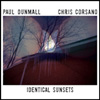 This memorable live collaboration between one of the world‚Äôs most explosive drummers and a titan of the UK jazz scene bizarrely came about from a random meeting at an airport in Portugal during Corsano‚Äôs lengthy tour with Bj√∂rk. As expected, the result is some absolutely incendiary free-jazz flame-throwing, but with some unexpected surprises thrown in too.
This memorable live collaboration between one of the world’s most explosive drummers and a titan of the UK jazz scene bizarrely came about from a random meeting at an airport in Portugal during Corsano’s lengthy tour with Björk. As expected, the result is some absolutely incendiary free-jazz flame-throwing, but with some unexpected surprises thrown in too.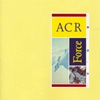 This reissue of ACR’s Factory Records swansong captures the band at the height of their popularity and influence, spearheading (along with New Order, Quando Quango, and others) the dancification of the celebrated Manchester indie scene. While inventive, funky, and certainly a proto-Madchester touchstone, it doesn’t hold up quite as well as their Simon Topping-era earlier work (perhaps because dance music evolves a hell of a lot faster than punk). Of course, I am very much predisposed to "tense and brooding" over "funky and fun," so I may not be the target demographic here. Still, I suspect that this is probably the sort of classic album where you had to be there to fully appreciate it.
This reissue of ACR’s Factory Records swansong captures the band at the height of their popularity and influence, spearheading (along with New Order, Quando Quango, and others) the dancification of the celebrated Manchester indie scene. While inventive, funky, and certainly a proto-Madchester touchstone, it doesn’t hold up quite as well as their Simon Topping-era earlier work (perhaps because dance music evolves a hell of a lot faster than punk). Of course, I am very much predisposed to "tense and brooding" over "funky and fun," so I may not be the target demographic here. Still, I suspect that this is probably the sort of classic album where you had to be there to fully appreciate it. The album starts with a soda can being opened: the click of aluminum as the tab is pressed down, the tsssh sound of carbonation being released into the air, the hissing fizz of cola. It ends with the sound of the can being crushed and thrown to the ground with a rattle and clunk. In this caffeine-fueled, densely layered and politically charged audio collage, we are taken on a ride through the billion-dollar advertising campaigns for Pepsi and Coke, the vagaries of the cola wars, celebrity endorsements, and torture. While Negativland are not generally known for their catchy hooks, upbeat rhythms, and memorable lyrics, Dispepsi remains a great "pop" album.
The album starts with a soda can being opened: the click of aluminum as the tab is pressed down, the tsssh sound of carbonation being released into the air, the hissing fizz of cola. It ends with the sound of the can being crushed and thrown to the ground with a rattle and clunk. In this caffeine-fueled, densely layered and politically charged audio collage, we are taken on a ride through the billion-dollar advertising campaigns for Pepsi and Coke, the vagaries of the cola wars, celebrity endorsements, and torture. While Negativland are not generally known for their catchy hooks, upbeat rhythms, and memorable lyrics, Dispepsi remains a great "pop" album.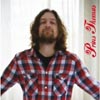 Prins Thomas's solo debut full length is a long, evolving, synthesized dream shuffle through some heady landscapes. His expertise makes sense of the fluid mind-body connection in the music of dance, psychedelia and German electronica.
Prins Thomas's solo debut full length is a long, evolving, synthesized dream shuffle through some heady landscapes. His expertise makes sense of the fluid mind-body connection in the music of dance, psychedelia and German electronica.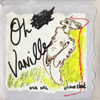
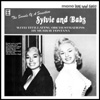 After years of hearing about the mythical NWW but never actually hearing them, I finally broke down and ordered this album (then an expensive import) when I was 19. Despite the kitschy title and cover art, I was still completely caught off-guard by the cartoonish and self-indulgently absurd music within and immediately dismissed it as something so dreadful that probably only a Zappa fan could like it (I remember trading it to a used record store for a Carcass album or something later that same week). Many years later, with a somewhat broader mind and some increased context, I decided to give it another chance.  I still find it cartoonish and willfully annoying, but it's also kind of crazily inspired.
After years of hearing about the mythical NWW but never actually hearing them, I finally broke down and ordered this album (then an expensive import) when I was 19. Despite the kitschy title and cover art, I was still completely caught off-guard by the cartoonish and self-indulgently absurd music within and immediately dismissed it as something so dreadful that probably only a Zappa fan could like it (I remember trading it to a used record store for a Carcass album or something later that same week). Many years later, with a somewhat broader mind and some increased context, I decided to give it another chance.  I still find it cartoonish and willfully annoying, but it's also kind of crazily inspired.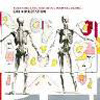 The methods used by Jonathan S. Podmore and Peter Hope on Dry Hip Rotation were quite oblique as far as strategies go. Storming the studio with little more than a few scrounged AKS synths, a violin, harmonica, and whatever else happened to be lying around they managed to smash together their art punk masterpiece in a mere six days, presumably so they could rest on the seventh. The majority of the music produced on the album does not even come from sources generally thought of as musical instruments. Everything from a Creda 400 tumble drier to toilets and scaffolding pipes are used (Joe Meek would have been proud). The outstanding lyricism and vocal performance of Peter Hope coupled with Jonathan’s tape loops (several meters in length) make for a riveting listen.
The methods used by Jonathan S. Podmore and Peter Hope on Dry Hip Rotation were quite oblique as far as strategies go. Storming the studio with little more than a few scrounged AKS synths, a violin, harmonica, and whatever else happened to be lying around they managed to smash together their art punk masterpiece in a mere six days, presumably so they could rest on the seventh. The majority of the music produced on the album does not even come from sources generally thought of as musical instruments. Everything from a Creda 400 tumble drier to toilets and scaffolding pipes are used (Joe Meek would have been proud). The outstanding lyricism and vocal performance of Peter Hope coupled with Jonathan’s tape loops (several meters in length) make for a riveting listen.
